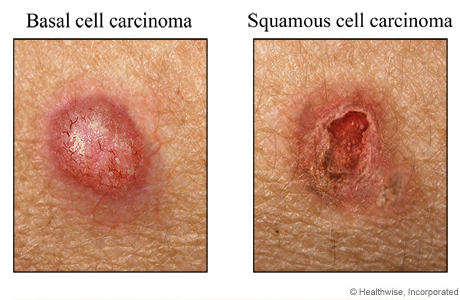Basal and Squamous Cell Carcinoma
Current as of: December 19, 2018
Author: Healthwise Staff
Medical Review:E. Gregory Thompson, MD – Internal Medicine & Kathleen Romito, MD – Family Medicine & Amy McMichael, MD – Dermatology
These pictures are examples of what skin cancer might look like. Basal cell carcinoma usually affects the head, neck, back, chest, or shoulders. The nose is the most common site. Signs of basal cell carcinoma can include skin changes such as a: Firm, pearly bump with tiny blood vessels that look spidery…
Current as of: December 19, 2018
Author: Healthwise Staff
Medical Review:E. Gregory Thompson, MD - Internal Medicine & Kathleen Romito, MD - Family Medicine & Amy McMichael, MD - Dermatology
12/19/2018
This information does not replace the advice of a doctor. Healthwise, Incorporated, disclaims any warranty or liability for your use of this information. Your use of this information means that you agree to the Terms of Use. Learn how we develop our content.


These pictures are examples of what skin cancer might look like.
Basal cell carcinoma usually affects the head, neck, back, chest, or shoulders. The nose is the most common site. Signs of basal cell carcinoma can include skin changes such as a:
Squamous cell carcinoma usually affects the face, head, or neck. Signs of squamous cell carcinoma include any:
Current as of: December 19, 2018
Author: Healthwise Staff
Medical Review:E. Gregory Thompson, MD – Internal Medicine & Kathleen Romito, MD – Family Medicine & Amy McMichael, MD – Dermatology
This information does not replace the advice of a doctor. Healthwise, Incorporated, disclaims any warranty or liability for your use of this information. Your use of this information means that you agree to the Terms of Use. Learn how we develop our content.
Current as of: December 19, 2018
Author: Healthwise Staff
Medical Review:E. Gregory Thompson, MD - Internal Medicine & Kathleen Romito, MD - Family Medicine & Amy McMichael, MD - Dermatology
12/19/2018
This information does not replace the advice of a doctor. Healthwise, Incorporated, disclaims any warranty or liability for your use of this information. Your use of this information means that you agree to the Terms of Use. Learn how we develop our content.
